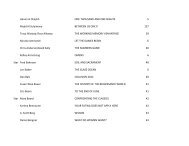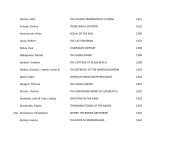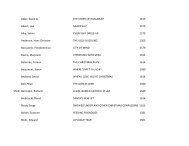nonfiction
nonfiction
nonfiction
Create successful ePaper yourself
Turn your PDF publications into a flip-book with our unique Google optimized e-Paper software.
“Provocative Yes. The last word<br />
on evolution No, but a stimulating one all the same.”<br />
from proving darwin<br />
French forces resisted; the Americans suffered hundred of casualties)<br />
and then piloted the ships, successfully reaching the airport<br />
despite obstructions, collisions and enemy fire.<br />
An entertaining story of individual heroism, which<br />
Brady surrounds by an equally entertaining account of the<br />
North African invasion, the largest amphibious operation<br />
in history at the time. (8-page black-and-white insert)<br />
JOHN F. KENNEDY<br />
Brinkley, Alan<br />
Times/Henry Holt (192 pp.)<br />
$23.00 | May 8, 2012<br />
978-0-8050-8349-1<br />
The admirable American Presidents<br />
series nears its end with another slim but<br />
astute biography by another big-league<br />
historian, this time Brinkley (The Publisher:<br />
Henry Luce and His American Century,<br />
2010, etc.).<br />
The reputations of his predecessor (Eisenhower) and successor<br />
(Lyndon Johnson) are rising steadily; not so with John<br />
F. Kennedy (1917-1963), whose middle-of-the-pack rating has<br />
changed little. This seems a fair evaluation of his actual accomplishments,<br />
admits Brinkley, who adds that he left an enormous<br />
legacy as a charismatic leader and a glamorous symbol of<br />
hope and purpose long after his death. He was the handsome,<br />
unscholarly, self-indulgent son of Joseph Kennedy, whose enormous<br />
wealth and ambition cleared his path through Massachusetts<br />
and then national politics. As a congressman and senator,<br />
Kennedy may have been more conservative than Eisenhower—<br />
more fiercely anti-Soviet, in favor of military spending, uninterested<br />
in domestic reform and civil rights and an admirer of<br />
Joseph McCarthy. Elected our youngest president in 1960 by a<br />
tiny margin, his charm enchanted the nation despite a first year<br />
that included the disastrous Bay of Pigs invasion and bungled<br />
Vienna summit. Experience and input from advisors, including<br />
his brother, Robert Kennedy, improved his performance and<br />
social conscience, but Congress rejected his bills advancing civil<br />
rights, tax reform, aid to education, medical care for the elderly<br />
and antipoverty efforts. All passed under Lyndon Johnson, who<br />
possessed political skills that Kennedy lacked.<br />
Plenty of long, definitive works exist, but Brinkley<br />
takes his job seriously, filling 160 pages with a thoughtful,<br />
opinionated biography.<br />
THE OCCUPY<br />
HANDBOOK<br />
Byrne, Janet--Ed.<br />
Back Bay/Little, Brown (256 pp.)<br />
$15.99 paperback | Apr. 17, 2012<br />
978-0-316-22021-7<br />
A succinct body of essays by knowledgeable,<br />
sympathetic observers on the grievances<br />
of the Occupy Wall Street protestors.<br />
Byrne (A Genius for Living: The Life of<br />
Frieda Lawrence, 1995) organizes the collection<br />
into three parts: “How We Got There,” “Where We Are Now”<br />
and “Solutions.” Economists Paul Krugman and Robin Wells give<br />
a crisp historical overview on how the excoriated “1 percent” quadrupled<br />
its real income between 1979 and 2007, leaving America<br />
as unequal as it had been on the eve of the Great Depression and<br />
unable to implement an adequate government policy because of<br />
the recent Congressional paralysis. Philip Dray reminds readers of<br />
the “enduring and seminal” legacy of protest movements preceding<br />
OWS, such as the Great Rail Strike of 1877 and the spontaneous<br />
lunch-counter sit-ins by black students in Greensboro, N.C., in 1960.<br />
Michael Hiltzik finds a good lesson in the Townsend movement of<br />
1933, which demanded government attention to the concerns of<br />
the aged. Unsurprisingly, the machinations of Wall Street dominate<br />
many of the essays: John Cassidy delves into what was good about<br />
Wall Street (addressing the capital-raising needs of their clients) and<br />
how it went terribly dysfunctional (exploiting instantaneous trading<br />
movements), while the reform of the tax system garners vigorous<br />
responses, such as those from Peter Diamond and Emmanuel Saez.<br />
Joel Bakan severely scrutinizes the “psychopathic personhood” of<br />
corporations, and Eliot Spitzer proposes income-contingent loans<br />
for struggling students. Some of the most fleshed-out essays put the<br />
OWS protests into a wider worldwide perspective—e.g., Nouriel<br />
Roubini’s simplified economics tutorial on the toll of globalization;<br />
and Robert M. Buckley’s daring assessment of the parallels between<br />
OWS and the pan-European uprisings of 1848. Other notable contributors<br />
include Pankaj Mishra, Barbara Ehrenreich, Paul Volcker,<br />
Robert Reich, Scott Turow and Jeffrey Sachs.<br />
An educational, highly useful primer on what’s broken<br />
and how to fix it.<br />
THE VOW<br />
The True Events<br />
that Inspired the Movie<br />
Carpenter, Kim & Carpenter,<br />
Krickitt with Wilkerson, Dana<br />
Broadman & Holman (210 pp.)<br />
$14.99 paperback | Feb. 10, 2012<br />
978-1-4336-7579-9<br />
A husband’s vapid memoir about a<br />
car crash that left his wife unable to recognize<br />
him.<br />
Never underestimate what a star-studded Hollywood movie<br />
can do for a poorly written book. Carpenter’s account of the<br />
1993 car crash that changed his family’s life was first published<br />
in 2000. The recent film retold the story with leads Channing<br />
Tatum and Rachel McAdams. Unfortunately, the actual narrative<br />
leaves much to be desired. Carpenter’s book opens with the<br />
author reminiscing about how he met his wife Krickitt over the<br />
telephone. One conversation with her was enough to make him<br />
feel like a “nervous, lovesick teenager.” Soon, Carpenter, who<br />
lived in New Mexico, was calling Krickitt, who lived in California,<br />
almost every day. After a brief Christian courtship, the<br />
two decided to marry. But their conjugal bliss was shattered<br />
when the newlyweds were involved in a collision that changed<br />
everything “in the blink of an eye.” Carpenter escaped with<br />
physical injuries that eventually healed, but Krickitt experienced<br />
brain trauma that changed her personality and took away<br />
all recollection of her husband and their shared past. Carpenter<br />
eventually won back his wife by helping her through a long<br />
rehabilitation process, but Krickitt never recovered any of her<br />
memories of their courtship and marriage. Despite the story’s<br />
inherent drama, Carpenter only skims the surface of the underlying<br />
emotional tension, and the amateurish writing (“It was as<br />
if she decided to be the friendliest, most helpful person her customers<br />
talked to every day. If that was the case then she was a<br />
roaring success in my mind”) and flat character portraits further<br />
hamstring the narrative.<br />
A saccharine, thoroughly lackluster paean to the power<br />
of eternal love.<br />
JACKIE AFTER O<br />
One Remarkable Year<br />
When Jacqueline<br />
Kennedy Onassis Defied<br />
Expectations and<br />
Rediscovered Her Dreams<br />
Cassidy, Tina<br />
It Books/HarperCollins (288 pp.)<br />
$24.99 | May 1, 2012<br />
978-0-06-199433-3<br />
A biography of Jacqueline Kennedy<br />
Onassis (1929–1994) focusing on a pivotal year in her life, 1975.<br />
Former Boston Globe reporter and editor Cassidy (Birth: The<br />
Surprising History of How We Are Born, 2006) sets out to prove<br />
that Onassis, though arguably a socialite, was no dilettante—<br />
that her seemingly sudden decision to immerse herself in the<br />
worlds of literature and historical preservation was born of<br />
longstanding interest and expertise in both. The author uses<br />
1975, the year in which Onassis was widowed for the second time,<br />
to examine this transformation from wife to activist and editor.<br />
Rather than creating focus, though, this lens often refracts.<br />
Cassidy includes detailed biographical information from earlier<br />
parts of her subject’s life in order to contextualize the choices<br />
she made during this pivotal year. Therefore, though that single<br />
year organizes the book, each of its significant events—her second<br />
husband’s death, her work as a consulting editor for Viking,<br />
her rejection of the political posts offered to her—is examined<br />
broadly, not deeply. For example, the chapter about her<br />
involvement in the campaign to maintain Grand Central Station’s<br />
status as a landmark site is as much about her restoration<br />
of the White House and her involvement in the preservation of<br />
Lafayette Square in Washington, D.C. Throughout, Cassidy is<br />
highly sympathetic to Onassis. She quotes Sally Quinn, a Washington<br />
Post writer who criticized Onassis in the fall of 1975 (“she<br />
is going literary-journalistic because…that’s where the glamour<br />
is, and the action”) and promptly dismisses her: “Quinn used<br />
the journalistic disguise of her own thoughts by inserting what<br />
‘skeptics’ thought.” Cassidy offers no evidence for this assertion,<br />
leaving readers unable to determine whether or not Quinn was<br />
actually voicing a common criticism of the time.<br />
A well-researched but limited account of a year in the<br />
life of Jackie O.<br />
PROVING DARWIN<br />
Making Biology<br />
Mathematical<br />
Chaitin, Gregory<br />
Pantheon (144 pp.)<br />
$24.00 | May 8, 2012<br />
978-0-375-42314-7<br />
978-0-307-90746-2 e-book<br />
From a renowned mathematician, a<br />
collection of a series of lectures on “Metabiology:<br />
Life as Evolving Software”—<br />
a “philosophy and history of ideas course on how and why to<br />
approach biology mathematically.”<br />
Chaitin (Meta Math! The Quest for Omega, 2005, etc.) equates<br />
DNA with a universal programming language, software that<br />
“can presumably express any possible algorithm, any set of<br />
instructions for building and running an organism.” He creates<br />
a model “toy” organism—pure DNA stripped of any cell<br />
parts or functioning metabolism—and studies how the organism<br />
evolves through mutations resulting from random walks<br />
in a huge software space. He makes the point that his model<br />
reflects the creativity and open-endedness of nature, in parallel<br />
with the incompleteness and open-endedness of mathematics<br />
itself, as Kurt Gödel proved. Throughout the text, Chaitin pays<br />
considerable homage to Gödel, Turing and von Neumann. The<br />
author’s model organisms do not stagnate but respond to the<br />
challenge of creating extremely large whole numbers by creating<br />
variations in the software (mutations) achieved by those<br />
random walks, mutations that are in fact algorithms, which<br />
translate to the organism’s increased fitness. Chaitin’s invocation<br />
of mutations that are whole programs rather than simple<br />
changes in a single letter of the DNA code is necessary for his<br />
proof, but it has the effect of taking the issue of natural selection<br />
out of biology and into pure mathematics. As such, questions<br />
are sure to abound, and the book is a bit esoteric for<br />
general readers. But credit the author for a lively style, lots of<br />
useful historical references and an appendix that includes von<br />
Neumann’s prescient essay on self-reproducing automata.<br />
Provocative Yes. The last word on evolution No, but a<br />
stimulating one all the same.<br />
810 | 15 april 2012 | <strong>nonfiction</strong> | kirkusreviews.com |<br />
| kirkusreviews.com | <strong>nonfiction</strong> | 15 april 2012 | 811






